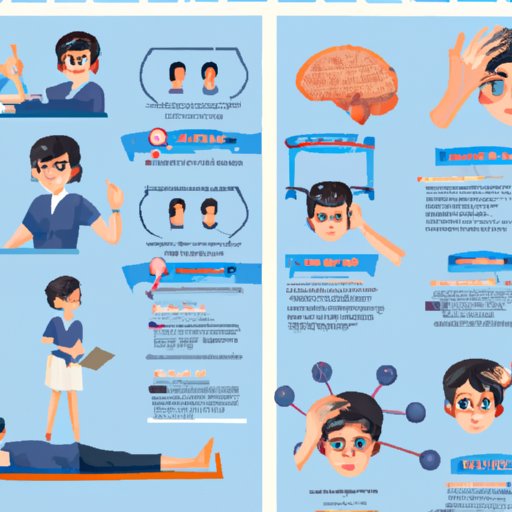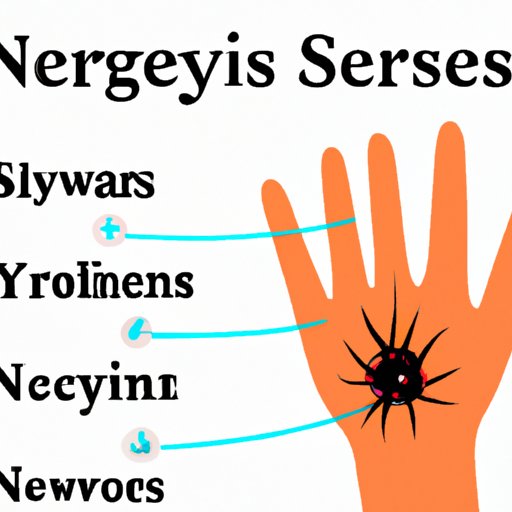
I. Introduction
The nervous system serves as our body’s communication system and plays a pivotal role in our body’s ability to function. It affects every aspect of our daily life, including our thinking, feeling, sensation, and movement. Therefore, it’s essential to regulate our nervous system to promote overall well-being.
This article aims to provide readers with simple techniques and strategies to regulate their nervous system. With these techniques, you can manage stress, improve your mental and physical health, and enjoy a better quality of life.

II. 5 Simple Techniques to Regulate Your Nervous System
Here are five simple techniques to regulate your nervous system:
1. Progressive Muscle Relaxation
Progressive Muscle Relaxation (PMR) is a technique that involves tensing and relaxing different muscle groups in your body, one at a time. This technique helps to release tension in your body, promoting relaxation and reducing stress. To do PMR:
- Lie down or sit in a comfortable position with your eyes closed.
- Take a deep breath and tighten the muscles in your right hand, making a fist.
- Hold your hand in a clenched position for five seconds, noticing the tension in your hand and forearm.
- Slowly release the tension in your hand, feeling the relaxation spread throughout your body.
- Repeat steps 2-4 with your left hand, then both your arms, shoulders, chest, back, stomach, legs and feet, working your way up to your head.
2. Grounding Techniques
Grounding techniques help you reconnect with the present moment and reduce stress by focusing your attention on something tangible around you. Try the following grounding technique when you feel overwhelmed:
- Look around and identify five things that you can see.
- Notice four things around you that you can touch.
- Identify three things you can hear.
- Focus on two things around you that you can smell or that you like the smell of.
- Identify one thing you can taste. With your feet planted firmly on the ground, take a deep breath and focus on the present moment.
3. Guided Imagery
Guided Imagery is a relaxation tool that allows you to create a mental image that promotes feelings of relaxation and calmness. You can use a guided imagery audio or create your own visualization. Here’s how to do a simple guided imagery exercise:
- Sit or lie down in a comfortable and quiet place.
- Close your eyes and take three deep breaths to relax your body.
- Visualize a place in your mind where you feel peaceful and happy – this could be a beach, forest, or peaceful meadow.
- Use your senses to explore this place in your mind – what do you see, hear, smell, or touch?
- Stay in this place for a few minutes, feeling relaxed and at ease.
- When you’re ready, take a deep breath and slowly open your eyes.
4. Yoga
Yoga is an ancient practice that combines physical postures, breathwork and meditation to promote overall health and well-being. Yoga helps to activate the relaxation response and decrease the stress response. Here’s a simple yoga practice that helps to regulate your nervous system:
- Start in a comfortable seated position with your eyes closed, take a few deep breaths.
- Breathe in, raise your arms overhead, and stretch upwards.
- Exhale, lower your arms, and bend forward from your hips, reaching for your toes.
- Inhale, lift your head and chest up halfway, hands on shins.
- Exhale, fold forward, chin to chest.
- Repeat this sequence six times.
5. Progressive Deep Relaxation
Progressive Deep Relaxation involves relaxing your body and calming your mind by focusing on different parts of your body, one at a time. This technique can help you release accumulated tension, alleviate anxiety and promote relaxation. Here’s how to do it:
- Lie down flat on your back in a quiet place and inhale and exhale deeply for a few minutes to unwind yourself.
- Starting from your right foot, move your attention up from your toes to the soles of your feet.
- Imagine your feet feeling soft and light.
- Move your focus to your right calf and imagine it softly release all tension and tightness.
- Move upward to the muscles of the right thigh, let them soften and feel relaxed.
- Continue this method up towards your head for 10-15 minutes.
- After you are done take a deep breathe and slowly open your eyes.
III. Foods That Can Help Regulate Your Nervous System
The kind of food you eat can affect your nervous system. Eating a healthy, balanced diet full of vitamins, and minerals can help your brain and nervous system function efficiently. Here are some foods that can help regulate your nervous system:
- Berries: Berries are a great source of antioxidants that can reduce inflammation, improve mood, and cognitive function.
- Fatty Fish: Fish like tuna, salmon, and sardines contain omega-3 fatty acids that can lower stress and reduce anxiety.
- Whole grains: Whole grains provide carbohydrates that ensure your brain and nervous system get a steady supply of energy.
- Greek Yogurt: Greek yogurt is an excellent source of protein and probiotics that can decrease stress levels and reduce anxiety.
- Dark chocolate: Dark chocolate can improve mood, focus and also reduce stress and anxiety. Its beneficial compounds, such as flavonoids, work as anti-inflammatory and neuroprotective agents.
IV. Breathing Exercises to Promote Nervous System Regulation
Breathing exercises can help regulate your nervous system by reducing anxiety and promoting relaxation. Try these two techniques:
1. Deep Breathing
- Sit comfortably and place your hands on your belly.
- Inhale through your nose for three seconds, filling your belly with air.
- Hold your breath for one second.
- Exhale for four seconds through your mouth, emptying your belly of air.
- Repeat for 5 to 10 minutes.
2. Box Breathing
- Sit down and relax for a few minutes.
- Breathe in for four seconds.
- Hold your breath for four seconds.
- Exhale for four seconds.
- Hold your breath again for four seconds.
- Repeat for at least four minutes.
V. How Exercise Can Help Regulate Your Nervous System
Exercise is an excellent way to improve overall health, including the nervous system. When you exercise, your body releases endorphins, which promote feelings of relaxation and happiness, and also helps to reduce depression and anxiety. Here are some exercises that can help regulate your nervous system:
- Running or jogging
- Walking or hiking
- Yoga
- Swimming
- Biking
VI. Mindfulness and Nervous System Health
Mindfulness practices help you live in the present moment and manage stress effectively. It can help to promote nervous system regulation, alleviate anxiety and promote calmness. Here’s a simple mindfulness meditation exercise:
1. Body Scan Meditation
- Find a comfortable seated position, close your eyes, and take three deep breaths.
- Shift your attention to your feet and notice how they feel.
- Breathe in and imagine sending breath to your feet. Then exhale and release it.
- Slowly move up through your body, stopping at each body part, and focus your awareness on it.
- Breathe in and out of each part and relax tension or stress you’re holding in that area.
- When you reach the top of your head, take three deep breaths before opening your eyes.
VII. Practicing Stress Management to Promote Nervous System Regulation
Long-term stress can negatively affect the nervous system, leading to anxiety and other health problems. Managing stress is essential for nervous system regulation. Here are some stress management techniques:
1. Journaling
Writing down daily thoughts, feelings, and events can help clear your mind and reduce stress levels. Try jotting down your thoughts for five to ten minutes a day to reduce stress levels.
2. Listen to Music
Listening to your favourite music can help to reduce anxiety and promote relaxation. Choose calm and peaceful music that can help release emotions and make you feel better.
3. Mindful Movement
Mindful movement practices such as yoga, Tai chi and Qigong incorporate slow, gentle movements with controlled breathing, promoting relaxation and reducing stress levels.
4. Avoid Overthinking
Learn to stop excessive worrying and overthinking to reduce stress levels. Create self-talk sentences that help to reduce anxiety levels and promote relaxation.
VIII. Conclusion
Regulating your nervous system helps you experience better overall health and improved well-being. The techniques and strategies discussed in this article provide you with simple and effective tools to manage stress levels, feel calmer, and improve mental and physical health. Try out these techniques and adopt the ones that work best for you.




